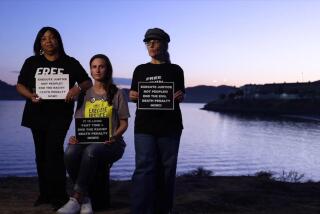Evidence pointing to LAPD officer in murder case ignored, suit claims

A veteran cold case detective ignored a key piece of evidence in an unsolved murder, delaying for several years the eventual discovery that Stephanie Lazarus, a Los Angeles police officer, was guilty of the killing, according to allegations in a lawsuit filed Wednesday.
The suit was filed in Los Angeles County Superior Court by Jennifer Francis, an analyst in the LAPD’s DNA laboratory. In it, Francis accused Cliff Shepard, a highly regarded investigator who recently retired, of disregarding the results of DNA tests she performed in the case. Those tests ultimately played a crucial role in identifying Lazarus as the killer when another detective reopened the case several years later.
Francis also alleged that Shepard knew Lazarus had ties to the murder victim and refused to investigate her as a suspect.
“Her DNA analysis indicated the direction of the investigation was not correct and that potential suspects were being improperly excluded,” the lawsuit states.
Francis is suing the LAPD, claiming supervisors have targeted her for retaliation and harassment because she drew attention to the overlooked tests.
In an interview with The Times, Shepard denied the allegations, calling them “absolutely untrue.”
The lawsuit stems from the 1986 killing of Sherri Rasmussen, a nurse who was found by her husband beaten badly and shot in their Van Nuys town house.
Overturned furniture and blood on the walls were evidence of a brutal struggle. Rasmussen’s head had been bludgeoned. Wounds on her wrist and cords on the floor indicated that she had been tied up. A thick robe with bullet holes in it lay nearby. Police suspected the killer used it to muffle the sound of the three gunshots fired at close range into Rasmussen’s chest.
Shortly after the murder, another home in the area was burglarized by two men who were not caught. Detectives developed the theory that Rasmussen had been killed by the burglars. The investigation languished without any solid leads and eventually went cold.
In late 2004, according to the lawsuit, the case had been reopened by the LAPD’s cold case unit and Francis performed tests on a saliva sample taken from a bite mark on Rasmussen’s arm. The tests revealed that the saliva had come from a woman, essentially upending the theory of two male burglars.
When she presented Shepard with the test results and suggested a woman might be involved, Francis claimed in the lawsuit that Shepard responded, “Oh, you mean the LAPD detective.”
Shepard went on to explain that he was aware a current detective in the department, who he did not name, had dated Rasmussen’s husband before he was married, Francis alleged in the lawsuit. Shepard dismissed the notion that this detective could be involved, allegedly saying to Francis, “She was not part of this.”
Shepard, in an interview, said he never discussed with Francis the possibility of a female officer being involved. He couldn’t have, he said, because he wasn’t even aware at the time that Lazarus or any female officer had any ties to Rasmussen.
“I thought, ‘OK, maybe it was a male and female burglar,’ ” Shepard recalled thinking when he learned of the DNA tests Francis performed. He added that at the time he and other detectives were actively investigating multiple serial killer cases that occupied much of his time.
The case remained cold for the next several years, until early 2009, when another detective, Jim Nuttall, was asked by a supervisor to take a look at the case.
Nuttall realized the possible significance of the tests Francis had run and began the search for female suspects. After re-interviewing Rasmussen’s parents and former husband, suspicion fell on Lazarus. A highly secretive investigation ensued, culminating with an undercover officer surreptitiously taking a DNA sample from Lazarus that was matched to the DNA in the saliva. Lazarus was convicted of the murder last year and sentence to 27 years to life in prison.
In the lead-up to Lazarus’ murder trial, Francis told a prosecutor and her supervisor about her conversations with Shepard and the delay in identifying Lazarus as a suspect, the lawsuit claimed.
A few months later, Francis alleged, she was ordered by one of the lab’s top supervisors to attend therapy sessions with a department psychologist. The move was made as “a pretext to harass her” and find out who else knew about the delay, the lawsuit claimed.
Francis’ attorneys John Taylor and Matthew McNicholas said the harassment has continued with work responsibilities being taken away from Francis -- punishment, they said, for criticizing the department’s handling of the investigation.
“People in LAPD panicked” about the overlooked test results, Taylor said. “So to save themselves or the LAPD, they tried to make Francis look like a wacky bird.”
Chief Charlie Beck declined to comment on Francis’ specific allegations, saying he had not yet been made aware of the lawsuit.
“Wrong roads were followed in that investigation,” Beck said. “But, that isn’t always a mistake. In any investigation you follow a million bad leads before you get your good one. Did we take too long? Yeah, we took too long. Was it because of this? We will have to see.”
Full coverage: Stephanie Lazarus
Twitter: @joelrubin
More to Read
Sign up for Essential California
The most important California stories and recommendations in your inbox every morning.
You may occasionally receive promotional content from the Los Angeles Times.












